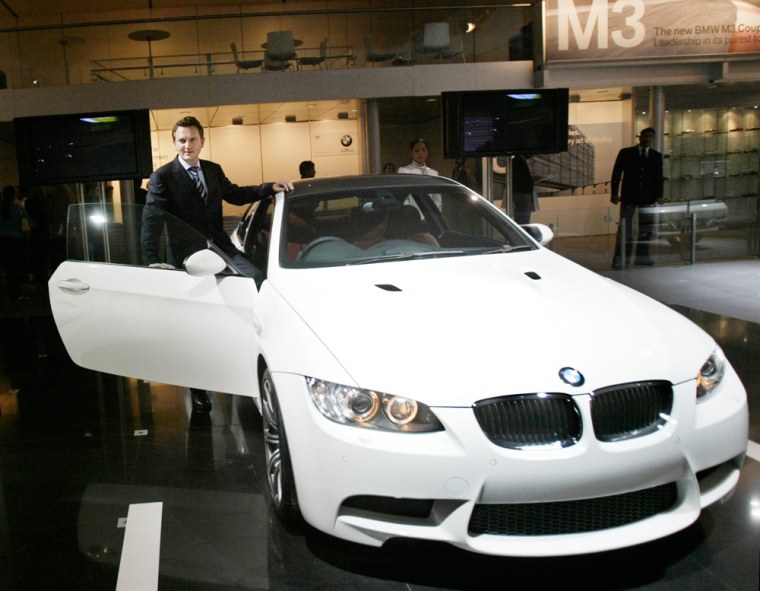If you’re of the view that today’s up-and-coming “Generation Y” workers tend to have a serious sense of self-entitlement, some surprising auto sales figures may support your position.
Take, for example, the BMW M3. You might expect this $62,000 Bavarian hot rod to be best suited to wealthy middle-aged car nuts, but instead the car has the lowest average customer age of any model in BMW’s line-up.
M3 buyers are surprisingly young, reports Larry Koch, M brand manager for BMW North America. While the average age of a buyer is 41, many M3 buyers are in their mid-20s, and others are closer to 56 — older enthusiasts finally buying the car they’ve long wanted.
“There is a two-humped profile for the M3’s age graph,” Koch said. “They are very young or they are old,” he said. “There are no 41-year-olds.”
It’s a similar story across the automobile industry. While fresh-out-of-school professionals, burdened with student loans and first-job salaries, might be expected to buy entry-level cars like Honda Civics or Toyota Corollas, instead many are choosing rides that fit the image they have of themselves as wealthy and successful, even though they haven’t yet achieved that status.
Members of “Gen Y” — a famously fickle age group loosely defined as those born between 1978 and 1994 — don’t feel they need to earn their luxury, observed Ed Kim, director of industry analysis for AutoPacific, which tracks the automotive industry.
“They want it now, and they feel they deserve it now,” he said.
This trend works to the benefit of automakers that produce "aspirational" vehicle models that younger buyers decide they deserve to own, even if, by conventional measures, they can’t afford them.
Scion’s most expensive model, the tC coupe, with a base price of about $17,000, has the brand’s youngest median age, according to company spokesman Wade Hoyt.
Executives of Honda's upscale Acura division have found that charging more for a fancier version of the same car can attract elusive young buyers who might stick around as long-term customers.
The Acura TL Type S, a sporty version of Acura’s top-selling four-door sedan — which itself is derived from the practical, workaday Honda Accord — boasts an average buyer’s age that is seven years younger than that of the less-expensive base car. And buyers of the Honda S2000 Club Racer — a version of the company’s two-seat roadster with race-ready suspension and no folding convertible top — are a full decade younger on average than buyers of the less-costly regular model.
“That was really shocking,” said John Watts, manager of product planning for Acura. “Any time you can get 10 years off the median age of a buyer that’s pretty significant.”
Smart, maker of the 8.8-foot-long two-seater fortwo, reports that its $11,000 base model, which you might think is perfect for young urbanites looking to avoid a big car payment, accounts for only 5 percent of the company’s sales, meaning that the vast majority of buyers go for upgraded versions that start at about $13,000 or $16,000.
Audi acknowledges the success its competitors have had making themselves so irresistible to younger car buyers that they’ll scrimp elsewhere to afford a prestigious car. Luxury carmakers like Mercedes-Benz and BMW offer a lot of lease financing to help customers afford their products.
“You get a fair amount of stretching [by young customers] to get into the brand,” observed Scott Keogh, chief marketing officer for Audi of the Americas. “That’s something Audi wants to get into.”
Acura wants to get in on the game too.
“We have to be ready with the financing,” said Watts. He added that younger buyers sometimes require a different approach.
“Young buyers are rabid,” he said. “They probably know significantly more about the car than the salesperson.”
That means that the sales staff should understand that young customers don’t want to be bored with recitations of specifications they already know, he added. “You don’t want the salesperson to drone on.”
But where, you might wonder, do today’s kids come up with the money to afford a $62,000 luxury German car?
“Common wisdom would hold that young people can dream about buying these cars, but that they couldn’t actually afford [them],” said Kim of AutoPacific.
The answer, he explained, is that youngsters are spending the rent money on their car payments.
“Generation Y is shaking out very differently to other generations,” said Kim. “There are unprecedented numbers of boomerang kids who come home after college and stay a long time.”
Living with the parents rent-free frees up cash for flashy rides like the M3, he said.
“They are not paying rent; they are not paying utilities. The temptation is huge to go out and buy a high-dollar performance car,” Kim said.
The trend is likely to continue for several reasons.
For one thing, the housing market downturn and resulting credit crackdown have put home-buying out of reach of many younger consumers who have decided to wait out the market in their old bedrooms.
Also, Kim said: “Generation Y is a lot closer to their parents than earlier generations were.”
So even if they are self-entitled brats, at least they are nice to their parents.
